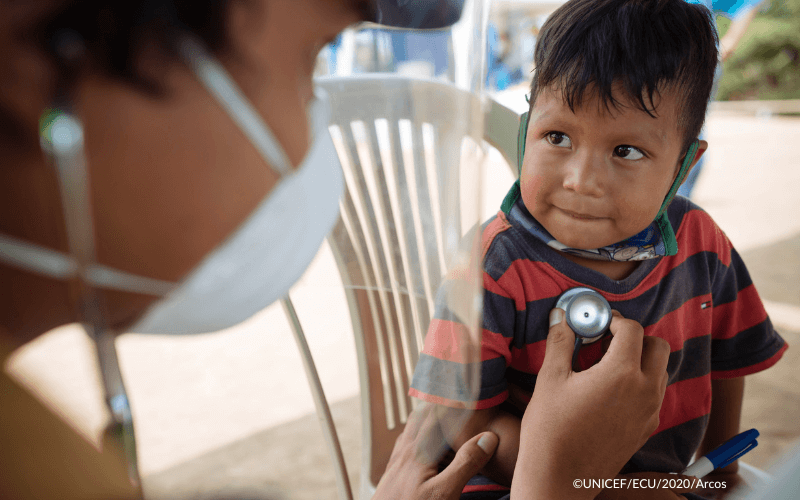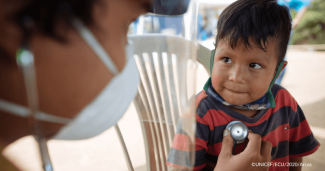Top Concerns Clinicians Should Have for Migrant and Immigrant Patients with the End of the Public Health and National COVID-19 Emergencies

[Editor’s note: This blog draws from an April 20, 2023 webinar, “How to Support Refugee, Immigrant, and Migrant Communities Before and After the End of the Public Health Emergency”, hosted by the National Resource Center for Refugees, Immigrants, and Migrants (NRC-RIM). The webinar included a panel discussion with Amy Liebman, MPA, MCN’s Chief Program Officer for Workers, Environment, and Climate, and Lizbeth Gonzalez, MAS, Senior Health Program Manager for International Rescue Committee Arizona (IRC), and was moderated by Syreeta Wilkins, Communications Strategist for NRC-RIM. It overviewed the impacts the end of the public health emergency will have for RIM communities.]
The public health emergency declaration on COVID-19 expires May 11th, and a separate national emergency declaration already ended two weeks ago -- but that does not mean COVID is over. There are still 255 deaths per day in the US due to COVID as of April 2023. Since 2020, grassroots community efforts have combated COVID in culturally and linguistically appropriate ways, which in turn changed the outcomes of COVID for many historically marginalized communities. These efforts were largely funded by the federal public health and national emergency declarations. These declarations also provided free vaccines, tests, and treatments, saving millions of lives. Policy changes enabled by the declarations also altered Medicaid requirements, increasing ease of access and inclusivity. For example, webinar panelists shared that since 2020 receivers of Medicaid have been on continuous enrollment, meaning people who are eligible for Medicaid did not have to reapply for coverage. This continuous enrollment decreased barriers for participants, saving them the difficulty of completing paperwork and navigating application websites. Other countless benefits also increased, including those addressing the economic impact of COVID, for example increases to the Supplemental Nutrition Assistance Program (SNAP).
As of May 11th, the emergency policies that enabled these beneficial changes will end, greatly impacting immigrant, migrant, and refugee patients and the work of the clinicians who serve them. With their expiration, federal support, including funding for COVID awareness, research, treatment, and prevention will be drastically limited. Just as the landscape of COVID has continually changed since 2020, this expected policy change will alter the environment of treatment and care of COVID for clinicians serving vulnerable communities in the US.
While federal policies may change, COVID is still taking the lives of people across the country and is still critically impacting the most vulnerable. Panelists urged clinicians across the US to continue to educate themselves on steps they can take now and after the declarations end to limit its detrimental impact on vulnerable communities. During the webinar, the panelists offered the following recommendations:
- Act now, before May 11th. Patients can still get vaccinated and stock up on free tests either through their insurance, government websites offering free tests, or local distribution centers before these policies take full effect.
- Help patients overcome barriers to care like negative social determinants of health. Panelists shared that higher restrictions on Medicaid and increased difficulty in applying for it will increase barriers to health care. Insurance is not the only barrier to care that RIM communities face, however. Panelists stressed that providing RIM clients with accurate updates on health care changes, as well as mapping food access availability, resources, and sliding scale options offered by local clinics, health departments, and federally qualified health centers, will be critical to continued health in these communities. Going back to the basics of COVID prevention and education in a culturally attuned and literacy-appropriate manner will also be critical in preventing potentially deadly COVID infections.
- Understand the different policies that affect care in your community. Panelists noted future COVID health care access for vulnerable communities may depend on state and county policies. Beyond the differences that exist among states and counties, if health care providers are aware of the differences in access to health care among vulnerable populations, they may be able to improve their ability to access care. For example, Moderna and Pfizer have suggested they will be offering free vaccines to the uninsured. Panelists shared that some refugees may qualify for federally funded COVID care support. For example, Refugee Medical Assistance (RMA) health care is available for many refugees up to 12 months after arrival. For communities without access to either Medicaid or RMA, employer health plans or the health insurance marketplace may offer options. For those who are ineligible, providing information about free clinics or federally qualified health centers can be instrumental in keeping these communities healthy.
- Partner with organizations active in your community. Continuing to work with organizations and other clinical organizations such as health departments and clinics will continue to be essential for limiting COVID infections in communities and decreasing extreme impacts to health. Panelists shared that for those wishing to work with refugee resettlement partners, utilizing the UN Refugee Agency resettlement partner web page can be helpful. Continuing to build trust and nurture relationships with patients is also important.
- Partner with local RIM employers. RIM community members often work in industries with environments that are dangerous to worker health and that have less worker protections than other workers in the US. For example, 70% of essential workers are immigrants. Working conditions where infectious disease continues to be more likely to spread, including meat packing plants where ventilation practices have still not made significant improvements, will continue to drastically impact the health of vulnerable communities. Additionally, housing where infectious diseases can spread more easily, such as the housing of many migrant farmworkers, will continue to be a concern. Panelists advised that moving forward beyond COVID, community organizations, health departments, and clinics must continue to nurture relationships with employers of vulnerable communities to educate, advise, and ask for their support in maintaining the health of immigrant and migrant employees. Employers were often more than eager to support the work of clinicians during the pandemic and maintaining these relationships can be instrumental in reducing barriers to health.
- Make sure treatment is a priority. Panelists noted that even if no or low-cost COVID services are unavailable, clinicians should urge patients not to delay treatment, and should remind them that severe illness and even death is more costly than treatments that can prevent COVID and long COVID.
- Treatment should especially be prioritized for those working in high-risk environments. Often RIM workers work in industries with no sick leave, especially with the end of the public health emergencies. Seeking treatment is especially important for these patients and those working in industries where infection is more likely due poor ventilation.
- Document work-related COVID. Panelists also urged clinicians to document whether patients contracted COVID at work. Being clear in patients’ charts that work was the likely cause can serve as evidence of the connection between their patient’s illness and work and could be instrumental in providing resources such as workers compensation or disability for the patient if they were to get severely ill, contract long COVID, or die due to their infection.
Around 70% of workers deemed “essential” during the pandemic are immigrants. Yet, despite their essential status, the working conditions that put them at significantly higher risk of illness during the peak of the pandemic have not improved. Meat packing plants continue to have poor ventilation; migrant housing remains poorly ventilated and overcrowded. This is a serious and concerning public health issue, said Liebman, which clinicians need to be aware of.
“Worker health and safety is public health,” Liebman emphasized. “The end of the public health emergency for our refugee, immigrant, and migrant communities, in essence, deepens the divide between the insured and the uninsured,” Liebman said, pointing out the many barriers vulnerable communities will continue to face with the end of the public health emergencies. To effectively bring an end to this public health emergency, the underlying conditions that migrants, immigrants, and refugees face at work need to be addressed, at a local and national level – otherwise, health disparities will continue to put these populations at risk for illness.
The webinar highlighted many helpful resources from NRC-RIM, MCN, AND IRC. See below for resources.
Resources
Webinar: Supporting Refugees, Immigrants, and Migrants Before & After the End of the Public Health Emergency |
NRC-RIM hosted webinar “Supporting Refugees, Immigrants, and Migrants Before & After the End of the Public Health Emergency |
Fact Sheet: HHS Announces ‘HHS Bridge Access Program For COVID-19 Vaccines and Treatments’ to Maintain Access to COVID-19 Care for the Uninsured | HHS.gov |
Federal announcement for the HHS Bridge Access Program For COVID-19 Vaccines and Treatments. |
Federal search tool for COVID‑19 vaccine locations |
A federal website that assists the public with finding distribution sites for COVID-19 vaccines. |
Federally funded free at-home COVID-19 test website |
A federal website where the public can order free COVID tests. |
What’s the end of Public Health Emergency for COVID-19? | MCN |
A downloadable handout in English and Spanish that informs readers on how to prepare for the end of the Public Health Emergency for COVID. |
COVID Emergency Declarations Are Ending. What Happens to Migrant & Immigrant Health and Health Access? | MCN |
A blog overviewing potential impacts to Migrant and Immigrant health and health care access after the end of the COVID Emergency Declaration. |
FAQ: COVID-19 and Migrant, Immigrant, and Food & Farm Worker Patients | MCN |
Migrant Clinicians Network continues to receive questions from our clinical network on COVID-19 and vaccines for migrant, immigrant, and farmworker communities. IN MCN’s award-winning FAQ, we offer our newest questions and answers followed by an archive of previous questions. |
Resource mapping Template | MCN |
This template assists in mapping internal and external community resources and can also be used to map community services in light of changes due to the end of COVID emergency orders. |
COVID-19 Vaccine Awareness Campaign Resources | MCN |
These resources include editable materials for awareness campaigns. All materials are adaptable to any language. Print and social media campaign materials, resources for campaign organizers, a campaign manual, images, toolkits, and other materials are available. The materials are low-literacy and use high-quality graphics for an image-centric approach. |
Updates to Bivalent COVID-19 Vaccine Eligibility Handout | MCN |
This handout overviews updated recommendations for COVID-19 vaccine administration as of April 18, 2023. |
Article: What’s at Stake as the US Ends Covid Emergency Measures – 4/2/23 - Bloomburg |
This article provides an update on the status of COVID in the US, information on the emergency declaration, Medicaid changes, and changes with the end of the COVID emergency declaration. |
Article: The End of the COVID-19 Public Health Emergency: Details on Health Coverage and Access – KFF |
The Kaiser Family Foundation shares updates on topics including vaccines, at-home COVID tests, PCR and rapid tests in a clinical setting, COVID treatment, and telemedicine in light of the end of the COVID public health emergency. |
End of the Public Health Emergency | National Resource Center for Refugees, Immigrants, and Migrants (NRC-RIM) (nrcrim.org) |
These resources developed by NRC-RIM covers changes in Medicaid coverage, food assistance, and COVID-19 healthcare due to the end of the public health emergency. |
International Rescue Committee | International Rescue Committee (IRC) |
The International Rescue Committee website. |
- Log in to post comments
